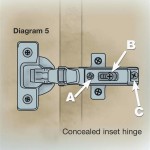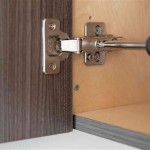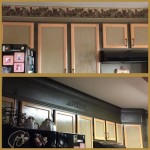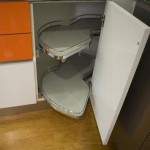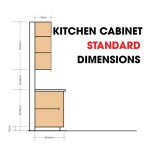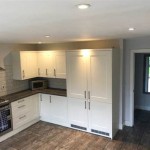Hinges For Kitchen Cabinet Doors: A Comprehensive Guide
The functionality and aesthetic appeal of kitchen cabinets are heavily reliant on the quality and appropriate selection of hinges. These seemingly small components play a crucial role in the smooth operation of cabinet doors, their longevity, and overall appearance. Understanding the different types of hinges available, their specific applications, and factors influencing their selection is essential for both professional cabinet makers and homeowners undertaking kitchen renovations.
The purpose of this article is to provide a comprehensive overview of hinges specifically designed for kitchen cabinet doors. It will delve into the various types of hinges, their distinguishing features, considerations for selecting the most appropriate hinge for a given application, and offer insights into installation and maintenance practices.
Types of Hinges for Kitchen Cabinet Doors
The market offers a wide array of hinges suitable for kitchen cabinet doors, each with its unique design and functionality. Selecting the right type depends on several factors, including the cabinet style, overlay style, desired functionality, and budget. Here's a breakdown of some of the most common types:
1. European Hinges (Concealed Hinges): Also known as cup hinges or concealed hinges, these are by far the most popular choice for modern kitchen cabinets. They are called "concealed" because when the cabinet door is closed, the hinge mechanism is not visible. They offer a clean, streamlined look.
European hinges consist of two main parts: a cup that is mortised into the back of the cabinet door and an arm that attaches to the inside of the cabinet frame. They are typically adjustable in multiple directions (horizontal, vertical, and depth), allowing for precise door alignment. Adjustment screws allow for fine-tuning to ensure the doors hang perfectly square and that gaps are consistent.
European hinges come in various configurations, including full overlay, half overlay, and inset. Full overlay hinges are used when the cabinet door completely covers the cabinet frame. Half overlay hinges are used when the cabinet door covers half of the frame, typically in situations with two doors sharing a center stile. Inset hinges are used when the cabinet door fits flush within the cabinet frame.
A significant advantage of European hinges is their soft-close functionality. Many modern European hinges incorporate a hydraulic mechanism that gently closes the door, preventing slamming and reducing wear and tear on the cabinet. This feature enhances the user experience and contributes to the longevity of the cabinets.
2. Face Frame Hinges: Face frame hinges are designed for cabinets with a face frame – a wooden frame attached to the front of the cabinet box. Unlike frameless cabinets, face frame cabinets have this added layer of wood around the opening.
There are several types of face frame hinges, including:
a. Wrap-Around Hinges: These hinges wrap around the face frame, providing a secure and stable connection. They are relatively easy to install and are a good option for DIY projects.
b. Mortise Hinges: Mortise hinges require a recess (mortise) to be cut into both the face frame and the cabinet door. While they offer a flush appearance and a strong connection, installation can be more demanding and requires precision.
c. Non-Mortise Hinges: As the name suggests, these hinges do not require a mortise. They are surface-mounted to the face frame and the cabinet door, making them easier to install than mortise hinges. However, they may not be as aesthetically pleasing as mortise hinges.
3. Butt Hinges: Butt hinges are a traditional type of hinge that consists of two leaves joined by a pin. One leaf is mortised into the cabinet door, and the other is mortised into the cabinet frame. They are commonly used for inset cabinet doors, providing a classic and timeless look.
Installing butt hinges requires precise mortising to ensure that the doors hang properly. The hinge leaves need to be flush with the surface of the door and frame for smooth operation. While they can be durable, they generally lack the adjustability of European hinges.
4. Pivot Hinges: Pivot hinges allow a cabinet door to swing open around a single pivot point, rather than along a traditional hinge line. They are often used for full overlay doors, creating a sleek and modern appearance.
Pivot hinges are typically installed at the top and bottom of the cabinet door, allowing it to swing open a full 180 degrees or more. They can be a good choice for cabinets where space is limited, as they minimize the swing radius of the door.
5. Self-Closing Hinges: This refers to a feature found in many of the above hinge types. The hinge mechanism incorporates a spring that automatically pulls the door closed when it is within a certain range. This prevents doors from being left ajar and helps maintain a neat and organized appearance.
Key Considerations When Selecting Hinges
Choosing the right hinges for kitchen cabinet doors involves considering several factors to ensure optimal functionality, durability, and aesthetic appeal. A careful assessment of these factors will lead to a more satisfying and long-lasting result.
1. Cabinet Style and Overlay: The style of the cabinet (framed or frameless) and the overlay type (full, half, or inset) are primary determinants in hinge selection. European hinges are typically used for frameless cabinets, while face frame hinges are designed for cabinets with a face frame. The overlay type dictates the specific configuration of the hinge required.
For example, a full overlay frameless cabinet necessitates a European hinge designed for full overlay applications. Similarly, an inset cabinet door requires a butt hinge or a specialized inset European hinge.
2. Door Weight and Size: Heavier and larger doors require more robust hinges to support their weight and prevent sagging or warping. The hinge manufacturer's specifications typically indicate the maximum door weight and size that a particular hinge can handle. Exceeding these limits can lead to premature hinge failure and damage to the cabinet doors.
For particularly heavy doors, consider using additional hinges to distribute the weight more evenly. This will prolong the life of the hinges and ensure smooth operation.
3. Desired Functionality: Consider the desired functionality of the cabinet doors. Do you want soft-close functionality? Do you need hinges with a wide opening angle? Answering these questions will help narrow down the options.
Soft-close hinges are a popular choice for modern kitchens, providing a luxurious feel and reducing noise. Hinges with a wide opening angle (165 degrees or more) can provide better access to the cabinet interior, especially in corner cabinets.
4. Durability and Material: Kitchen cabinet hinges are subjected to frequent use and should be durable enough to withstand the demands of daily life. Hinges made from high-quality materials, such as solid brass or stainless steel, are more resistant to corrosion and wear and tear.
Consider the finish of the hinge as well. A durable finish will help prevent the hinge from tarnishing or corroding over time. Powder-coated finishes are a good option for areas that are exposed to moisture.
5. Budget: Hinge prices can vary significantly depending on the type, material, and features. Set a budget and choose hinges that offer the best value for money. While it's tempting to opt for the cheapest option, investing in higher-quality hinges can save money in the long run by reducing the need for replacements and repairs.
Installation and Maintenance
Proper installation and regular maintenance are crucial for ensuring the longevity and optimal performance of kitchen cabinet hinges. Incorrect installation can lead to misalignment, sagging, and premature failure. Neglecting maintenance can result in squeaking, sticking, and corrosion.
1. Installation: Follow the manufacturer's instructions carefully when installing hinges. Use the correct tools and techniques to avoid damaging the hinges or the cabinet doors. Ensure that the hinges are properly aligned and securely fastened.
For European hinges, a hinge boring jig can be helpful for creating the accurately sized cup holes in the cabinet doors. For mortise hinges, use a sharp chisel and a steady hand to create the mortises.
2. Adjustment: Most adjustable hinges, especially European hinges, offer horizontal, vertical, and depth adjustments. Use these adjustments to fine-tune the door alignment and ensure that the gaps between the doors are consistent. A small screwdriver is typically all that is needed for these adjustments.
3. Lubrication: Periodically lubricate the hinges with a light oil or silicone spray to prevent squeaking and sticking. Apply the lubricant sparingly to the hinge pin and moving parts.
4. Cleaning: Clean the hinges regularly with a damp cloth to remove dust and grime. Avoid using harsh chemicals or abrasive cleaners, as these can damage the finish.
5. Tightening: Check the hinge screws periodically and tighten them if necessary. Loose screws can cause the hinges to shift and the doors to become misaligned.
By understanding the different types of hinges available, carefully considering the factors influencing their selection, and following proper installation and maintenance practices, it is possible to ensure that kitchen cabinet doors function smoothly, look aesthetically pleasing, and provide years of trouble-free service.

Kitchen Cabinet Door Hinges Pictures Options Tips Ideas

Types Of Cabinet Hinges The Home Depot

Standard Cabinet Door Hinge 110 Degree

The Ultimate Guide To Kitchen Cabinet Hinges

Kitchen Cupboard Door Hinges Fixings Sds London

Hinge Repair Plate For Kitchen Cabinet Door Kit 1pcs To 8pcs Com

What Are The Best Kitchen Cabinet Hinges Titus

Types Of Furniture And Kitchen Cabinet Hinges Furnica

Types Of Cabinet Hinges The Home Depot

Cabinet Door Hinges Self Closing Soft Close Rejs Ltd
Related Posts


